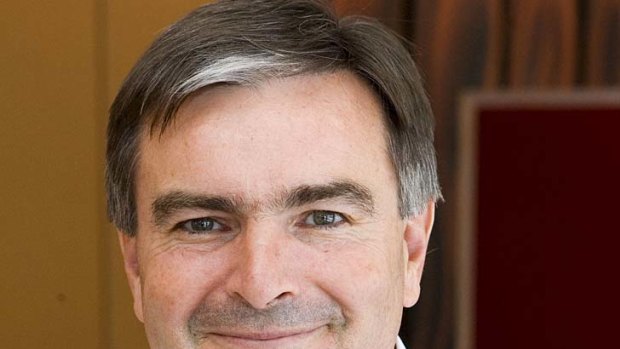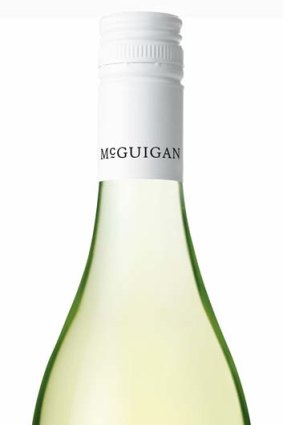This was published 12 years ago
Hunter Valley winemaker launches 'semillon blanc'
From one Australian winery comes the tale of the little semillon that could.
By Huon Hooke
If the taste of Marlborough sauvignon blanc is so popular, why is traditional Australian semillon so unpopular?
It is a question that has plagued semillon producers and lovers, especially from the Hunter Valley, for the past decade or so as New Zealand sauvignon blanc has blithely taken over the world.

Blanc check ... winemaker Neil McGuigan with The Semillon Blanc.
''Savvy'', as the Kiwis call it, accounts for 70 per cent of the New Zealand grape crop and Marlborough, thanks to sauvignon, now produces more than half of all that nation's wine.
The world has fallen in love with the wine, none more so than Australians. Our biggest-selling wine is a Marlborough sauvignon.

The Semillon Blanc.
But Australian semillon is also a light, fresh, fruit-driven style of dry white, which has a lightly herbal fruit character, not a hell of a lot different to sauvignon, really. So why is it in the doldrums?
Hunter wine producer McGuigan estimates sauvignon is selling 3.4 million cases a year in this country, while semillon is doing about a one-hundredth of that - 40,000 cases. In dollar terms, sauvignon is worth $438 million compared with semillon's $5.6 million. The picture is healthier if you include blends of sauvignon blanc and semillon (just under a million cases, worth $104 million).
While semillon sales fall, semillon sauvignon blends grow at a healthy rate but not as fast as sauvignon, which powers along at 18 per cent a year.
It's enough to scare the daylights out of Australian winemakers.
They've had no choice but to look in helpless horror as their market is progressively eaten away by Kiwi producers.
Now, an Australian winery has decided to do something about it; McGuigan has launched a wine labelled The Semillon Blanc.
The packaging is clever and the target buyer is influenced by this. It looks good and has a simple message on its label. The name is The Semillon Blanc 2011 ($12.99) with the words ''Refreshing, crisp and aromatic''.
Some buyers will probably assume it's a semillon sauvignon blanc blend but that's not the intention, according to chief winemaker Neil McGuigan. ''It could happen but it's not a concern,'' he says.
The smartest thing is the wine: it's 100 per cent semillon but McGuigan decided the Hunter Valley, traditionally a semillon producer, could not make the wine he had in mind.
It's not a traditional Tyrrell's semillon style of 10 per cent alcohol, a pH of 2.9 and a Chablis profile. ''That would be too lean; too light.''
Instead, the grapes are mainly from the Murray Valley (the Riverland and Sunraysia) with a little Barossa Valley. It's 11.5 per cent alcohol, which is still very light wine, but the pH is higher - 3.35 - which means the wine is softer and tastes less acidic. There is a smidgin of sweetness, between four and five grams per litre but most people won't notice it. The overall effect is lightness with softness and a clean finish. Unlike traditional Hunter semillon it probably won't age well but that's not the objective. As McGuigan jokes: ''From the day we bottled it, we have 364 days left to sell it.''
He could have achieved a similar result by blending in a little chardonnay, perhaps, but I suspect it's a point of pride to a Hunter man that the wine is all semillon… and when some tasters commented its aroma reminded them of sauvignon blanc, he retorted: ''There's not a berry of sauvignon blanc in it''.
The wine is already doing exceptionally well in Britain. ''This wine has single-handedly lifted McGuigan's semillon sales in the UK by 52 per cent,'' he says.
A 2010 vintage was test-marketed through Tesco supermarkets at $10.50 (£6.99), and quickly became McGuigan's second best selling wine after shiraz. Tesco competitor Sainsbury's was unhappy it didn't have it, McGuigan says, and influential British wine buyer Dan Jago reportedly described it as the most exciting new white wine from Australia in 10 years.
The 2011 is quite fragrant, in a citrus, passionfruit, gooseberry sort of way, with a hint of semillon varietal straw. It's delicate and finely textured but also soft and round, with gentle acidity and immediate drinkability.
The launch of The Semillon Blanc follows a dream run for McGuigan and its sister label, Tempus Two. The week before, Tempus Two Copper Zenith Semillon 2003 was named international best semillon at the International Wine Challenge in Britain, and the 2011 of the same wine won a gold medal at the Cairns Wine Show. The '03 was also NSW wine of the year in 2010.
Aussie winemakers scan the sauvignon blanc sales figures the way an outback cocky scans a drought-parched horizon for a cloud. Right now, they're just a little excited: after several years of growing at 25 per cent a year, sauvignon sales are faltering. Woo-hoo! But hang on a sec: they're still growing at 18 per cent a year. Don't spike the keg just yet.
TASTINGS BY HUON HOOKE
Penfolds a world-beater
In a highly significant result for Australia, Penfolds won the International Chardonnay Trophy at the International Wine Challenge in Britain, with its 2009 Bin 09A Reserve Chardonnay ($90). This already much-decorated wine has scooped four trophies all told. The others are the Australian Chardonnay Trophy, Australian White Trophy and Adelaide Hills White Trophy. The British trophy is a huge result. It means the wine was judged best chardonnay over all from France and other countries in a class that's one of the most hotly contested in any show. Australia also won the International Trophy for best dry riesling (McGuigan Shortlist Riesling 2004) and best fortified muscat (Stanton & Killeen Classic Rutherglen Muscat).
Orlando expands next door
Orlando Wines has bought the former Grant Burge cellar door sales complex at Rowland Flat, Barossa Valley in South Australia. The site is next to Orlando's Jacob's Creek Visitor Centre. Both sites were part of Jacob's Estate, established in the 1840s and which gave its name to Jacob's Creek. Orlando, which still has its winemaking base nearby, will take possession on July 1 next year. A project team is developing plans for the site.
Mitchelton set to change hands
Goulburn Valley winery Mitchelton looks set to change ownership. It's been owned by Lion Wine, formerly Lion Nathan, for about 10 years. The new owner is likely to be the Ryan family, which owns a vineyard, thoroughbred stud and upmarket caravan park in the area. Mitchelton specialises in marsanne, riesling, shiraz and Rhone red blends.
Tulloch's new Muse
Hunter Valley winemaker Keith Tulloch is about to embark on a new phase, which includes opening a restaurant. He is building a $2 million complex on Hermitage Road, Pokolbin, across the road from his present address. Scheduled to open in September, it includes a winery, offices, restaurant and wine club room. The eatery will be Muse Kitchen, a second restaurant for Troy Rhoades-Brown of Muse Dining.